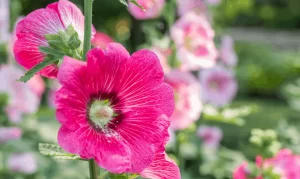Step by Step Guide to Planting & Caring for Hollyhock: If you are a fan of the old-fashioned garden, hollyhock is undoubtedly the best option. It is known as the old-fashioned garden flower. Many gardeners dream of successfully growing this flower in their garden. Because Hollyhock instantly enhances the aura of the garden with jewel colors and charm.
The flowers look beautiful from their youth, and having different colours increases its attraction. So, are you wondering how to plant hollyhocks? It will undoubtedly be a great choice to fill your garden will delight. Though they do not require heavy maintenance, some aspects to look at before planning to plant hollyhock.
Contents
About Hollyhock Flowers
Hollyhock belongs to the Malvaceae flower family. They grow all over Asia and Europe. There are many colours of hollyhock, such as blue, pink, red, black, etc. The most common variety is biennials. The flowers are tall, beautiful, and cottage-style flowers. The hollyhock leaves are like large fig trees coarse and palmate.
The life circle of the flower is over two years. In the initial year, the flower grows foliage and stores energy; in the 2nd year, the stalks shoot up, the flowers start blooming, and the seeds form. On the other hand, hollyhock leaves, roots, blossoms are edible and non-toxic. If you wonder how tall hollyhocks grow, the answer is the flowers can reach the height of 6-8 feet tall and 1-2 wide. So, if you have a cottage garden, then planting hollyhock is a must.
Where to Plant the Hollyhocks?
Every flower has its suitable area, and it does not adjust with all seasons. Hollyhock flowers should be planted in a well-drained area where the full sun should be in partial shade. As the height of the plant is very tall, you should protect it from heavy wind or storms. There should be some support system like wall, stake, fence. If there is no support system, then it might get broken. Hollyhocks are plants that self-seed if they are left to their own devices.
It would help if you located an area with no mess or nuisance, where nothing can easily harm it. Because of their height, it may come across with many problems like breakage, may get loose. Again, it should get adjusted with the provided soil. Some ideal soils for hollyhocks are loamy, sandy, chalky. The dry soil is forbidden for planting hollyhock flowers.
When to Plant Hollyhock Bulbs? How to plant Hollyhock
Firstly, you have to understand the whole process of planting. Hollyhock needs full sun and moist, rich, and well-drained soil. A common mistake that many growers make is planting the flower in dry soil. By that, the flowers do not get to their real growth ultimately die.
If you are planning about how to grow hollyhock from seeds, then follow the steps below:
- Sow the seeds outside a week before the last frost. But again, if you are planting seedlings out, you have to wait a bit like two to three weeks before the last frost.
- Hollyhocks have long taproots so if you seed it indoors, use tall, individual pots or transplant early. By that, there will be no chances of damage.
- Hollyhock seeds need to be planted right below the soil, no more than ¼-inch deep. Hollyhock flowers are tall, so the plants should be about 2 feet apart to grow well.
- The hollyhock needs time to germinate, like 10 to 14 days. If the root is showing at the base of the tray, they are entirely ready to move on.
- You might notice that the odd plant is trying to flower sooner but snip off the flower spike.
However, another way you can plant is by planting bare-root hollyhocks. But remember that some are biennials that may not bloom until their second year.
If you are thinking about when to plant hollyhock bulbs, then hollyhocks have roots; they do not have bulbs. However, some hollyhocks bulbs are sold at a reasonable price in the markets. But seeds give efficient results in growing the hollyhocks, and there will be no extra expenses using the seeds.
Hollyhock Care & Instructions
Hollyhocks are easy to grow and bloom in a very wide area. Hollyhock care is minimal compared with other flowers. You don’t have to obtain so many steps to keep it healthy and bloomy. Yet, other aspects should be considered well while planning hollyhocks. Some processes that should be applied are:
-
Pruning
Pruning for plants is always beneficial for the plant’s growth. Hollyhocks can be removed when they fall, and stalks can be cut back after flowering. This will not let the seed’s heads form and reseed.
If you want to keep the seeds, you can set them for the next spring, leaving the flowers and a few stalks until the seeds get dropped. All the seeds and stems must be removed to prevent rust diseases from winter.
-
Watering
The flowers need regular watering, and the soil should be moist for the hollyhocks. Remember to water from below and never give excess water.
-
Fertilizers
A light quantity of fertilizers can benefit the hollyhock plants and compost in the spring. There is no need to pouring a heavy sum of fertilizers.
-
Overwintering
In areas with heavy winter, hollyhocks can be grown there by using seeds in the container and overwintering indoors. Sprinkle a tiny amount of water, and when the weather gets warm-up, bring it out.
Nonetheless, if you are wondering, Is hollyhock harmful to humans? Then the flowers are not harmful to humans but can skin a slight irritation when touched. It is not good for pets like dogs and cats. It might be harmful to them.
Hollyhock Diseases
Hollyhocks have a short life span which means their varieties may last for a maximum of 2-3 years, but to the extent of their lifespan, you can remove the growing hollyhock flowers. But the flowers have to face the rust problem. It can be defined as a fungal infection. It is one of the major hollyhock problems that occur more often to the hollyhock flowers and its family.
Learn more about How Long for Gladiolus Bulb to Sprout
The signs of rust problem are:
- Yellow spots on leaves.
- Brown or rust colour bumps on the underside of the leaves.
- Black blotches on petioles.
No worries, preventing rushes is not a tough job. The few steps that can easily help your hollyhock flowers from these diseases are:
- Good air circulation.
- Regular watering from below.
- You can treat it with a fungicide.
Hollyhock Health Benefits
It does bring an enthralling look to the garden making the whole scenario look magnificent. It adds drama and grace, matching with other flowers making nature look more soothing to the eyes. The flowers easily attract butterflies and hummingbirds. It also benefits humans in many ways, such as:
- The flower is used to make the medicine tea.
- It helps to treat breathing disorders and digestive problems.
- It helps to heal skin burns and swelling issues.
Learn more about How to Start a Lavender Farm?
Final Thought: When to Plant Hollyhock Bulbs?
Hollyhocks are a true blessing of Mother nature. The tall flowers look gorgeous and offer unique splendor reflected in the sunny morning. The flowers are easy to grow, but plants always need extra care for their growth. We hope the information mentioned above will give you a better idea of how to plant hollyhock. If you apply all the processes with caution, you will surely be satisfied with the outcomes. Happy Planting!




